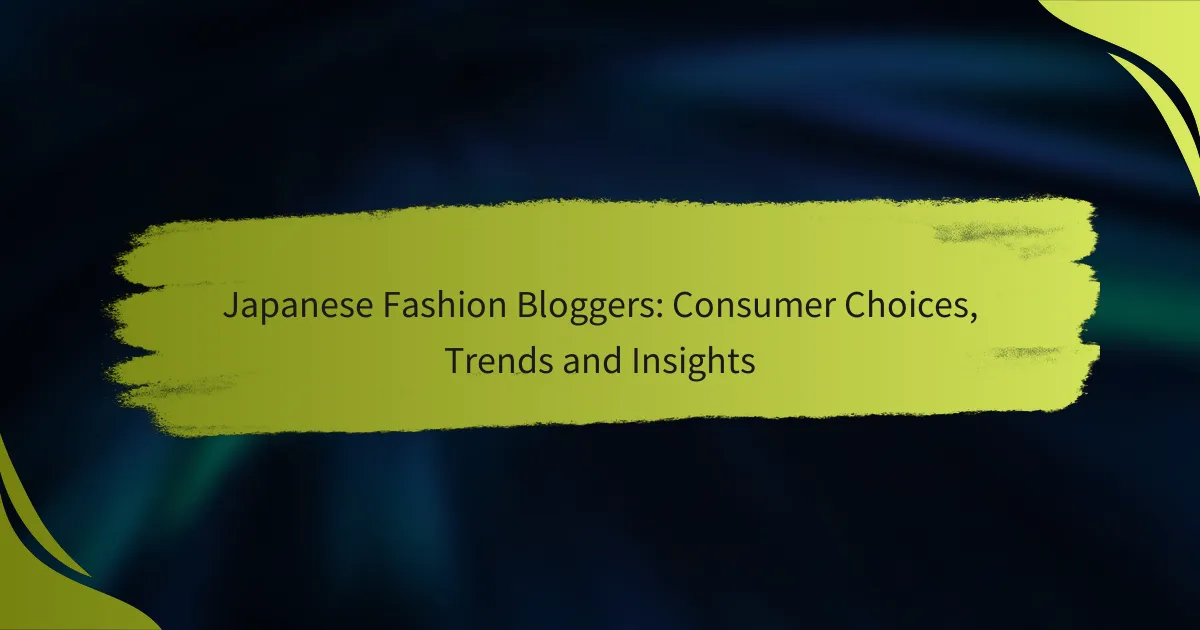Japanese fashion bloggers are at the forefront of a vibrant scene that merges street style with minimalist aesthetics and vintage influences. By focusing on eco-friendly brands and collaborating with local designers, they create culturally relevant content that resonates with their audience. Their authentic endorsements significantly influence consumer choices, making them pivotal figures in shaping trends within the fashion industry.
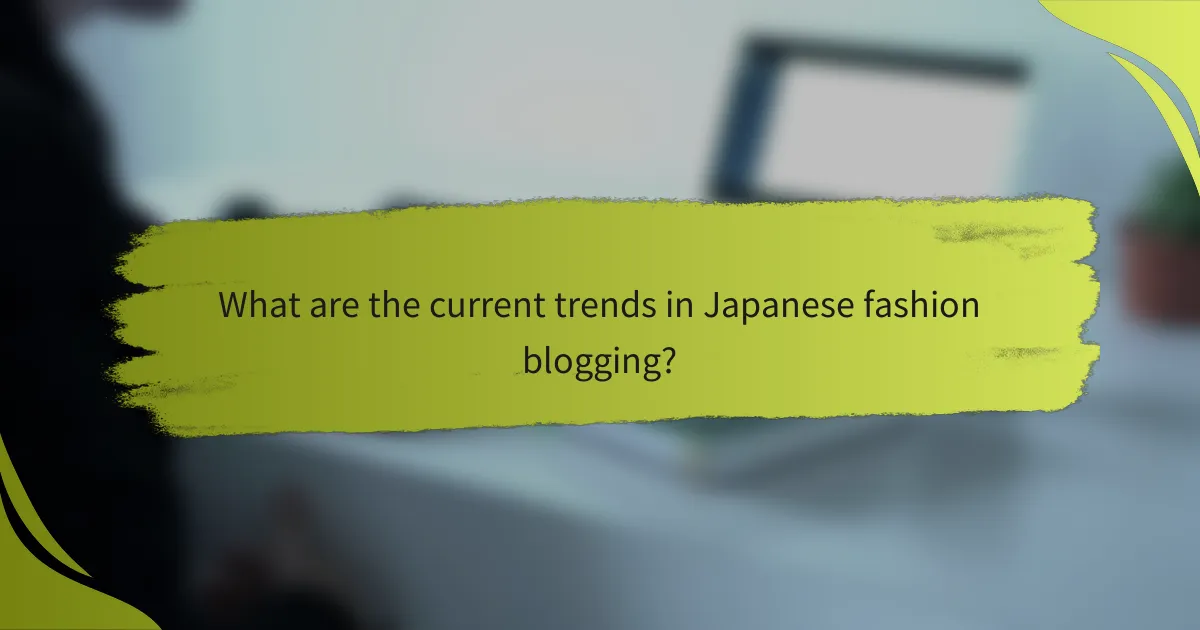
What are the current trends in Japanese fashion blogging?
Japanese fashion blogging is currently characterized by a blend of street style, minimalist aesthetics, and a resurgence of vintage fashion. Bloggers are increasingly focusing on eco-friendly brands and collaborating with local designers to create unique, culturally relevant content.
Street style influences
Street style plays a significant role in Japanese fashion blogging, showcasing everyday wear that reflects personal identity and urban culture. Bloggers often highlight local trends from districts like Harajuku and Shibuya, where eclectic styles emerge. This grassroots approach allows for a diverse range of fashion expressions, appealing to a wide audience.
To effectively incorporate street style into a blog, consider featuring local events or street interviews that capture the essence of the community. Engaging with followers through social media can also enhance visibility and interaction.
Minimalist aesthetics
Minimalist aesthetics are gaining traction among Japanese fashion bloggers, emphasizing simplicity and functionality. This trend often features neutral color palettes, clean lines, and versatile pieces that can be styled in multiple ways. Minimalism resonates with consumers seeking a more sustainable wardrobe by reducing the need for excessive clothing.
When adopting a minimalist approach, focus on quality over quantity. Highlight key wardrobe staples that are timeless and can be mixed and matched, providing practical styling tips for readers.
Vintage fashion resurgence
The resurgence of vintage fashion is a notable trend in Japanese blogging, with many influencers showcasing thrifted and retro pieces. This movement not only promotes sustainability but also celebrates unique styles from past decades, appealing to nostalgia and individualism. Vintage markets and online thrift stores are popular sources for these finds.
Bloggers can enhance their content by sharing tips on how to style vintage items or where to find the best thrift shops. Collaborating with vintage stores for giveaways or features can also attract a dedicated audience.
Eco-friendly brands
Eco-friendly brands are increasingly highlighted in Japanese fashion blogging, reflecting a growing consumer awareness of sustainability. Bloggers often promote brands that prioritize ethical production practices, use organic materials, and reduce waste. This trend aligns with a global shift towards conscious consumerism.
To effectively feature eco-friendly brands, provide insights into their practices and the benefits of sustainable fashion. Consider creating a list of recommended brands or products that align with these values, encouraging readers to make informed choices.
Collaborations with local designers
Collaborations with local designers are a key trend in Japanese fashion blogging, fostering a sense of community and cultural pride. Bloggers often partner with emerging designers to showcase unique collections that reflect local artistry and craftsmanship. These collaborations can lead to exclusive content and limited-edition pieces, attracting followers’ interest.
To leverage collaborations, bloggers should actively seek partnerships with local talent and promote these collaborations through social media and events. Highlighting the stories behind the designs can create a deeper connection with the audience and enhance the overall narrative of the blog.
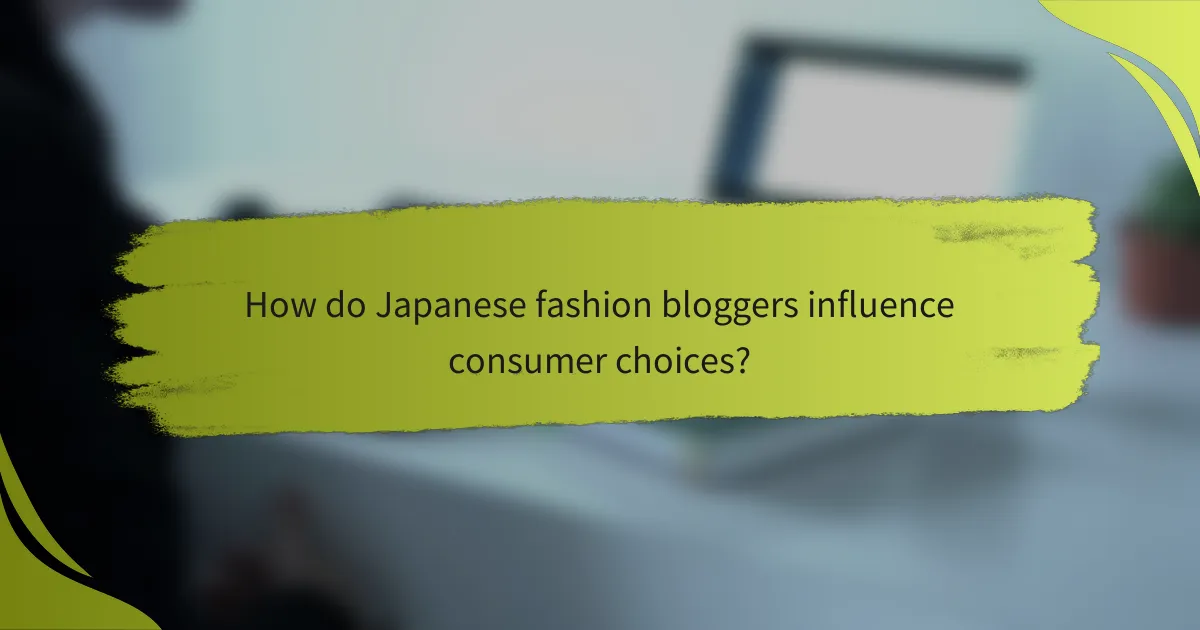
How do Japanese fashion bloggers influence consumer choices?
Japanese fashion bloggers significantly shape consumer choices by showcasing trends and products that resonate with their followers. Their authentic endorsements and unique styles create a direct impact on purchasing decisions, making them key players in the fashion industry.
Product endorsements
Product endorsements by Japanese fashion bloggers often lead to increased visibility and sales for brands. When a popular blogger features a specific item, it can quickly become a must-have among their audience. This phenomenon is particularly evident in Japan, where social media plays a crucial role in consumer behavior.
Brands frequently collaborate with bloggers to create sponsored content that highlights their products. These endorsements can range from casual mentions to dedicated posts, providing followers with a sense of trust and authenticity that traditional advertising may lack.
Style inspiration
Japanese fashion bloggers serve as vital sources of style inspiration, showcasing diverse looks that appeal to various demographics. Their ability to mix high-end and affordable pieces encourages followers to experiment with their own wardrobes. This blending of styles often leads to the emergence of new trends within the fashion landscape.
Many bloggers curate outfits that reflect seasonal trends, cultural influences, or personal aesthetics, making it easier for consumers to adopt similar styles. This practice not only fosters creativity but also drives demand for specific clothing items and accessories featured in their posts.
Brand loyalty development
Through consistent engagement and relatable content, Japanese fashion bloggers help cultivate brand loyalty among their followers. When bloggers share their positive experiences with a brand, it fosters a sense of community and trust, encouraging consumers to remain loyal to those brands.
Additionally, bloggers often provide exclusive discounts or early access to new collections, further incentivizing their audience to choose specific brands. This loyalty can translate into long-term customer relationships, benefiting both the bloggers and the brands they promote.
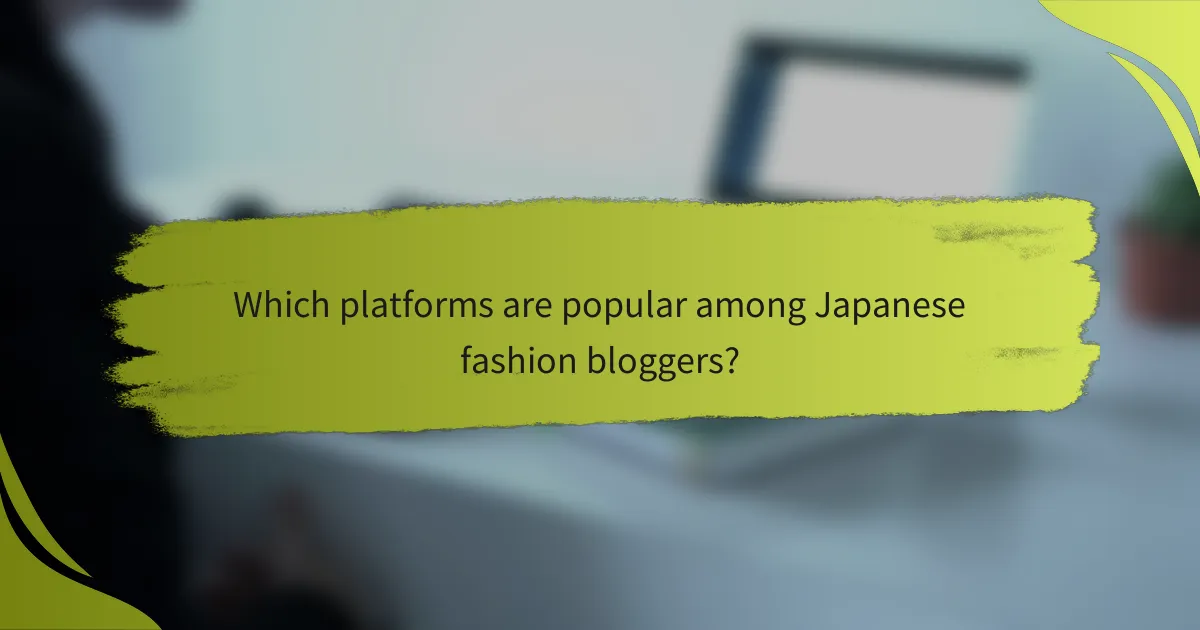
Which platforms are popular among Japanese fashion bloggers?
Japanese fashion bloggers primarily use platforms like Instagram, Twitter, blogging websites, and YouTube to share their insights and trends. Each platform offers unique features that cater to different aspects of fashion communication and audience engagement.
Instagram is a leading platform for Japanese fashion bloggers due to its visual-centric nature. Bloggers can showcase outfits, accessories, and lifestyle images, attracting followers through appealing aesthetics.
Utilizing features like Stories and Reels allows for dynamic content, while hashtags help increase visibility. Engaging with followers through comments and direct messages fosters a community around personal style.
Twitter serves as a real-time communication tool for Japanese fashion bloggers, allowing them to share quick updates, thoughts, and links to their latest content. The platform’s brevity encourages concise expression of ideas and trends.
Fashion bloggers often participate in trending topics and use hashtags to connect with broader conversations. This can enhance their visibility and establish them as thought leaders in the fashion community.
Blogging websites
Blogging websites provide a space for in-depth discussions and detailed fashion insights. Japanese fashion bloggers can create long-form content that explores trends, reviews products, and shares personal experiences.
These blogs often include high-quality images and links to products, making them a valuable resource for readers seeking comprehensive information. SEO optimization is crucial for attracting organic traffic to these blogs.
YouTube
YouTube is increasingly popular among Japanese fashion bloggers for video content that showcases styling tips, hauls, and tutorials. The platform allows for a more personal connection through visual storytelling and personality.
Fashion bloggers can engage their audience through vlogs and interactive content, such as Q&A sessions. Collaborations with other YouTubers can also expand their reach and introduce them to new audiences.
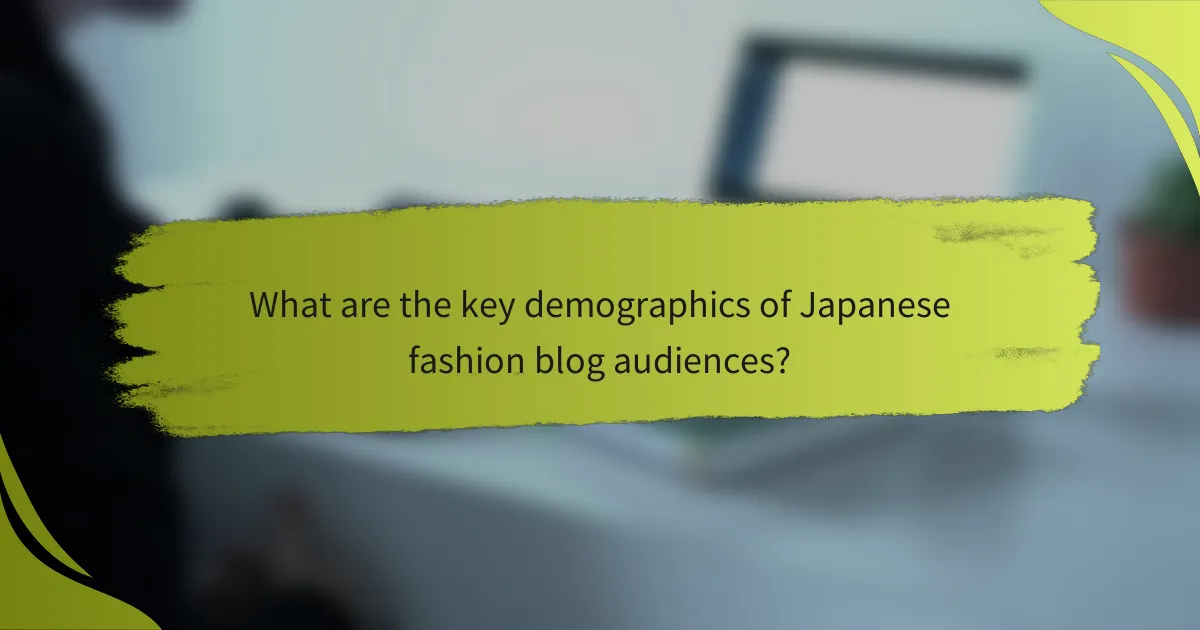
What are the key demographics of Japanese fashion blog audiences?
The key demographics of Japanese fashion blog audiences include a diverse range of age groups, gender distributions, and geographic locations. Understanding these demographics helps brands tailor their marketing strategies and content to better engage with their target consumers.
Age groups
Japanese fashion blog audiences predominantly range from their late teens to early thirties. This age group is particularly active in following trends and seeking fashion inspiration online. However, there is also a growing interest among older demographics, particularly those in their forties, who are exploring fashion blogs for style tips and lifestyle content.
Gender distribution
The gender distribution among Japanese fashion blog audiences tends to skew towards females, with women making up a significant majority. Female readers often seek advice on styling and the latest trends, while male audiences are increasingly engaging with fashion blogs focused on men’s style and grooming. Brands should consider this distribution when creating content and marketing campaigns.
Geographic locations
Most Japanese fashion blog audiences are concentrated in urban areas, particularly in cities like Tokyo and Osaka. These metropolitan regions are known for their vibrant fashion scenes and diverse consumer bases. However, interest is also growing in suburban and rural areas, where readers are looking for accessible fashion advice that suits their local lifestyles.

What criteria should brands consider when collaborating with bloggers?
Brands should evaluate several key criteria when collaborating with bloggers, including audience alignment, engagement rates, and content quality. Understanding these factors helps ensure that partnerships are effective and resonate with target consumers.
Audience Alignment
Audience alignment is crucial for successful collaborations. Brands need to analyze whether the blogger’s followers match their target demographic in terms of age, gender, and interests. For instance, a fashion brand targeting young adults should collaborate with bloggers whose audiences predominantly consist of that age group.
Additionally, brands should consider the geographical location of the blogger’s audience. Collaborating with local influencers can enhance brand visibility in specific markets, making campaigns more relevant and impactful.
Engagement Rates
Engagement rates are a vital metric to assess the effectiveness of a blogger’s influence. High engagement, indicated by likes, comments, and shares, suggests that the audience is actively interested in the content. Brands should look for bloggers with engagement rates that exceed industry averages, which can vary but often range from 2% to 5% for fashion-related content.
It’s also beneficial to analyze the type of engagement. For example, meaningful comments that indicate genuine interest in the blogger’s posts can be more valuable than mere likes, as they reflect a deeper connection with the audience.
Content Quality
The quality of content produced by bloggers is another essential criterion. Brands should review the blogger’s previous posts for professionalism, creativity, and alignment with the brand’s image. High-quality visuals and well-written captions can significantly enhance a brand’s message.
Moreover, brands should consider the blogger’s unique style and voice. Collaborating with bloggers who have a distinctive aesthetic can help brands stand out in a crowded market, making their products more memorable to consumers.
